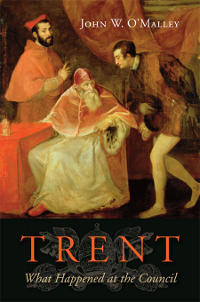 Jeg har nå lest ferdig Trent: What Happened at the Council, av John O’Malley, SJ, ei svært lærerik og god bok. Det er faktisk slik at dette er den første skikkelige gjennomgangen av konsilet i Trent. Vatikanet åpnet ikke alle arkivene fra Trent før ca 1880, og en stor gjennomgang av konsilet i fire bind fra 50-tallet er nesten ikke blitt oversatt til andre språk (bare bind 1 og 2 til engelsk).
Jeg har nå lest ferdig Trent: What Happened at the Council, av John O’Malley, SJ, ei svært lærerik og god bok. Det er faktisk slik at dette er den første skikkelige gjennomgangen av konsilet i Trent. Vatikanet åpnet ikke alle arkivene fra Trent før ca 1880, og en stor gjennomgang av konsilet i fire bind fra 50-tallet er nesten ikke blitt oversatt til andre språk (bare bind 1 og 2 til engelsk).
Det ble skrevet mange anmeldelser av boka da den kom i 2013, bl.a. HER, HER, HER og HER. Fra den siste anmeldelsen tar jeg med følgende utdrag:
The fact that only 29 bishops out of an episcopate of perhaps as many as 700 showed up for the council’s opening helped make it an object of derision and satire from its first moment. The further fact that it dragged on for a seemingly interminable length did not help its reputation. Its final decrees, moreover, are dense with theological and canonical technicalities that make them extraordinarily susceptible to misunderstanding except by for scholars initiated into the subtleties of canon law and medieval Scholasticism.
Aside from the decrees, which were published almost immediately, virtually all the background materials — records of the debates in the council, diaries, correspondence, etc. — were inaccessible until 1880 when the Vatican archives were opened. Even so, it took scholars from 1901 until 2001, a full century, to piece them together, edit them and finally begin publishing them.
With those volumes now in hand and with the scholarship, principally German, expended upon them since the volumes began appearing, we are finally able to dispel the myths and misunderstandings that have plagued the council for centuries. A big myth, for instance, is that the council was a smooth-functioning machine intent upon launching an offensive against Protestants and in making the Catholic laity tow the line in their behavior and thinking.
Like all myths, this one has more than a grain of truth in it. The council did, in fact, settle upon a set of procedures for itself that allowed it to function relatively smoothly, but there were just enough ambiguities in it to cause periodic explosions of outrage and denunciations that the council was being manipulated. The biggest ambiguity, which underlay many disruptions, was the pope’s relationship to the council. To what extent did the pope have the authority to determine the council’s course? If there ever was an issue-under-the-issues at the Council of Trent, this was it. Of it, however, the council’s final decrees breathe not a word.
While it is certainly true that the theologians and bishops at the council were heavily prejudiced against Luther and his followers, they tried their best to be fair. They realized, moreover, that at the insistence of Emperor Charles V the council was convoked to try to effect a reconciliation with the Reformers. That this utopian goal could not be attained was mainly due to factors beyond the council’s control. The hour was too late.
Fr O’Malley holder her (under) i 2013, på Gregoriana i Roma, en times forelesning om konsilet i Trent (med materiale fra boka) som man også kan lære mye av. (To personer innleder først, og så begynner O’Malley etter ca 7 minutter.)
